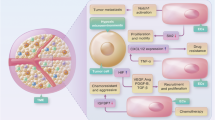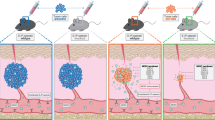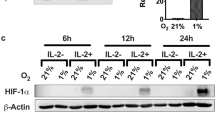Abstract
Introduction
Patients and mice with solid tumors, such as Lewis lung carcinoma (LLC), have defects in functions of immune effector cells. Endothelial cells, a component of the tumor vasculature, are potential regulators of immune cell functions. Therefore, these studies examined the impact of exposure to LLC tumor on the ability of endothelial cells to modulate immune cell functions.
Materials and methods
Endothelial cells were pre-treated with LLC tumor-conditioned medium (EndoT-sup) for 24 h. Control endothelial cells that were exposed to medium (EndoMedia) or epithelial cell-conditioned medium (EndoEpi-sup). After the initial 24 h incubation, endothelial cells were washed and fresh media was added. Cells were allowed to incubate for an additional 24 h. Supernatants from EndoMedia, EndoEpi-sup or EndoT-sup were collected and assayed for immune modulatory products and for immune modulatory activity.
Results
Supernatant from EndoT-sup contained increased levels of PGE2, IL-6 and VEGF as compared to EndoMedia and EndoEpi-sup controls. NK cell activity, as measured by TNF-α and IFN-γ secretion, was increased following exposure to media conditioned by EndoMedia and EndoEpi-sup. Exposure of NK cells to supernatants of EndoT-sup, also increases TNF-α and IFN-γ secretion, but to a lesser extent than by EndoMedia and EndoEpi-sup. Examination of macrophage functions demonstrated that supernatant from EndoT-sup decreased microbead phagocytosis and increased production of the immune suppressive mediators, IL-10 and PGE2. Lastly, T-cell responses to stimulation with anti-CD3 in the presence of supernatants from EndoT-sup were examined. IFN-γ production by CD8+ T-cells was reduced after exposure to EndoT-sup-conditioned medium, as compared to cells treatments with medium or control conditioned medium. Production of IFN-γ by CD4+ T-cells exposed to EndoT-sup was not altered.
Conclusions
Taken together, these studies demonstrate that tumors skew endothelial cells to disrupt NK cell, T-cell and macrophages functions, and represents a novel mechanism of tumor-induced immune suppression.









Similar content being viewed by others
References
Barker LP (2006) Mycobacterium leprae interactions with the host cell: recent advances. Indian J Med Res 123:748–759
Berg M, Wingender G, Djandji D, Hegenbarth S, Momburg F, Hammerling G, Limmer A, Knolle P (2006) Cross-presentation of antigens from apoptotic tumor cells by liver sinusoidal endothelial cells leads to tumor-specific CD8+ T cell tolerance. Eur J Immunol 36:2960–2970
Briscoe DM, Henault LE, Geehan C, Alexander SI, Lichtman AH (1997) Human endothelial cell costimulation of T cell IFN-gamma production. J Immunol 159:3247–3256
Curiel TJ, Coukos G, Zou L, Alvarez X, Cheng P, Mottram P, Evdemon-Hogan M, Conejo-Garcia JR, Zhang L, Burow M, Zhu Y, Wei S et al (1997) Specific recruitment of regulatory T cells in ovarian carcinoma fosters immune privilege and predicts reduced survival. Nature Med 10:942–949
Danese S, Dejana E, Fiocchi C (2007) Immune regulation by microvascular endothelial cells: directing innate and adaptive immunity, coagulation, and inflammation. J Immunol 178:6017–6022
Diehl S, Rincon M (2002) The two faces of IL-6 on Th1/Th2 differentiation. Mol Immunol 39(9):531–536
Elgert KD, Alleva DG, Mullins DW (1998) Tumor-induced immune dysfunction: the macrophage connection. J Leukoc Biol 64:275–290
Finke J, Ferrone S, Frey A, Mufson A, Ochoa A (1999) Where have all the T cells gone? Mechanisms of immune evasion by tumors. Immunol Today 20:158–160
Gallia GL, Tamargo RJ (2006) Leukocyte-endothelial cell interactions in chronic vasospasm after subarachnoid hemorrhage. Neurol Res 28:750–758
Leek RD, Harris AL (2002) Tumor-associated macrophages in breast cancer. J Mammary Gland Biol Neoplasia 7:177–189
Lizee G, Radvanyi LG, Overwijk WW, Hwu P (2006) Improving antitumor immune responses by circumventing immunoregulatory. Cells Mech 12:4794–4803
Katz SC, Pillarisetty VG, Bleier JI, Shah AB, DeMatteo RP (2004) Liver sinusoidal endothelial cells are insufficient to activate T cells. J Immunol 173:230–235
Kindle L, Rothe L, Kriss M, Osdoby P, Collin-Osdoby P (2006) Human microvascular endothelial cell activation by IL-1 and TNF-α stimulates the adhesion and transendothelial migration of circulating human CD14+ monocytes that develop with RANKL into functional. Osteoclasts 21:193–206
Konur A, Kreutz M, Knuchel R, Krause SW, Andreesen R (1996) Three-dimensional co-culture of human monocytes and macrophages with tumor cells: analysis of macrophage differentiation and activation. Int J Cancer 66:645–652
Krupnick AS, Gelman AE, Barchet W, Richardson S, Kreisel FH, Turka LA, Colonna M, Patterson GA, Kreisel D (2005) Murine vascular endothelium activates and induces the generation of allogeneic CD4 + 25+Foxp3+ regulatory T cells. J Immunol 175:6265–6270
Lefkowitz DL, Roberts E, Grattendick K, Schwab C, Stuart R, Lincoln J, Allen RC, Moguilevsky N, Bollen A, Lefkowitz SS (2000) The endothelium and cytokine secretion: the role of peroxidases as immunoregulators. Cell Immunol 202(1):23–30
Lejeune P, Lagadec P, Onier N, Pinard D, Ohshima H, Jeannin JF (1994) Nitric oxide involvement in tumor-induced immunosuppression. J Immunol 152:5077–5083
Lienenluke B, Germann T, Kroczek RA, Hecker M (2000) CD154 stimulation of interleukin-12 synthesis in human endothelial cells. Eur J Immunol 30:2864–2870
Ma W, Pober JS (1998) Human endothelial cells effectively costimulate cytokine production by, but not differentiation of, naive CD4+ T cells. J Immunol 161:2158–2167
Mantovani A, Schioppa T, Porta C, Allavena P, Sica A (2006) Role of tumor-associated macrophages in tumor progression and invasion. Cancer Metastasis Rev 25(3):315–322
Mitsuhashi M, Liu J, Cao S, Shi X, Ma X (2004) Regulation of interleukin-12 gene expression and its anti-tumor activities by prostaglandin E2 derived from mammary carcinomas. J Leulock Biol 76(2):322–332
Nazareth MR, Broderick L, Simpson-Abelson MR, Kelleher RJ Jr, Yokota SJ, Bankert RB (2007) Characterization of human lung tumor-associated fibroblasts and their ability to modulate the activation of tumor-associated T cells. J Immunol 178:5552–5562
Ohira H, Abe K, Yokokawa J, Takiguchi J, Rai T, Shishido S, Sato Y (2003) Adhesion molecules and CXC chemokines in endotoxin-induced liver injury. Fukushima J Med Sci 49:1–13
Ohm JE, Gabrilovich DI, Sempowski GD, Sempowski E, Parman KS, Nadaf S, Carbone DP (2003) VEGF inhibits T-cell development and may contribute to tumor-induced immune suppression. Blood 101:4878–4886
Papamichail M, Perez S, Gritzapis A, Baxevanis C (2004) Natural killer lymphocytes: biology, development and function. Cancer Immunol Immunother 53:176–186
Pirtskhalaishvili G, Nelson JB (2000) Endothelium-derived factors as paracrine mediators of prostate cancer progression. Prostate 44:77–87
Pockaj BA, Basu GD, Pathangey LB, Gray RJ, Hernandez JL, Gendler SJ, Mukherjee P (2004) Reduced T-cell and dendritic cell function is related to cyclooxygenase-2 overexpression and prostaglandin E2 secretion in patients with breast cancer. Ann Surg Oncol 11(3):328–339
Rodig N, Ryan T, Allen JA, Pang H, Grabie N, Chernova T, Greenfield EA, Liang SC, Sharpe AH, Lichtman AH, Freeman GJ (2003) Endothelial expression of PD-L1 and PD-L2 down-regulates CD8+ T cell activation and cytolysis. Eur J Immunol 33:3117–126
Young MR (2004) Trials and tribulations of immunotherapy as a treatment option for patients with squamous cell carcinoma of the head and neck. Cancer Immunol Immunother 53:375–382
Young MR, Wright MA, Matthews JP, Malik I, Prechel M (1996) Suppression of T cell proliferation by tumor-induced granulocyte-macrophage progenitor cells producing transforming growth factor-beta and nitric oxide. J Immunol 156:1916–1922
Acknowledgments
This work was supported by the Research Service of the Department of Veterans Affairs and by grants R01CA85266 and R01CA97813 from the National Institutes of Health to MRIY.
Author information
Authors and Affiliations
Corresponding author
Rights and permissions
About this article
Cite this article
Mulligan, J.K., Lathers, D.M.R. & Young, M.R.I. Tumors skew endothelial cells to disrupt NK cell, T-cell and macrophage functions. Cancer Immunol Immunother 57, 951–961 (2008). https://doi.org/10.1007/s00262-007-0425-x
Received:
Accepted:
Published:
Issue Date:
DOI: https://doi.org/10.1007/s00262-007-0425-x




